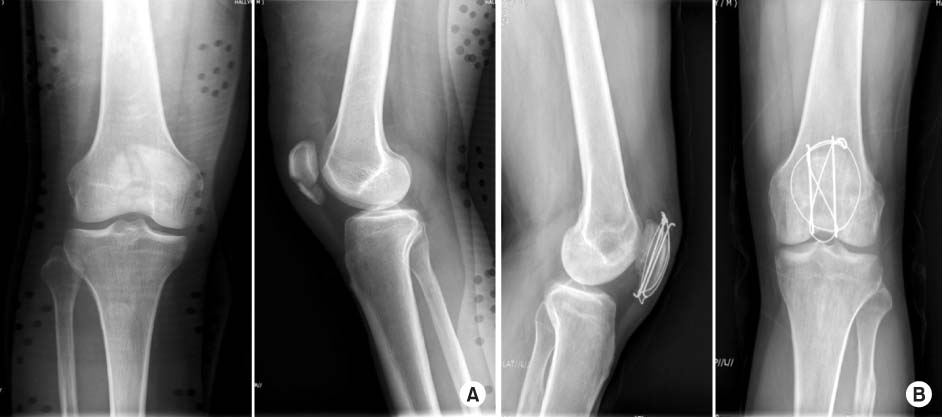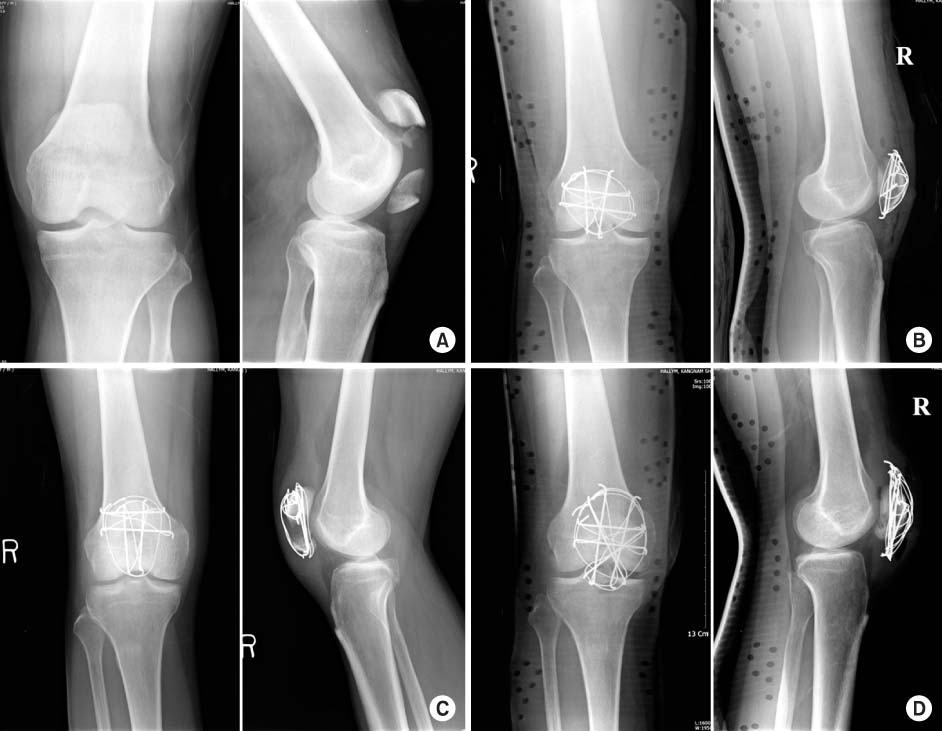J Korean Fract Soc.
2014 Jul;27(3):206-212. 10.12671/jkfs.2014.27.3.206.
Results of Tension Band Wiring and Additional Circumferential Wiring in Treatment of Comminuted Patella Fracture
- Affiliations
-
- 1Department of Orthopaedic Surgery, Kangnam Sacred Heart Hospital, Hallym University College of Medicine, Seoul, Korea. chungkjmd@dreamwiz.com
- KMID: 1708713
- DOI: http://doi.org/10.12671/jkfs.2014.27.3.206
Abstract
- PURPOSE
The purpose of this study is to evaluate the results of tension band wiring and additional circumferential wiring in treatment of comminuted patella fractures.
MATERIALS AND METHODS
A retrospective study of 67 patients with follow-up period longer than six months who underwent tension band wiring and additional circumferential wiring for comminuted patellar fracture from January 2004 to December 2012 was conducted. Analysis was based on radiological evaluation of bony union and articular surface displacement, and clinically by evaluating the postoperative function of the knee joint using the Levack scoring system.
RESULTS
Only one case out of 67 (1.5%) showed nonunion without metal breakage while good bone union was achieved in all other cases. Excluding the nonunion case, range of motion was 90 degrees minimum, 135 maximum, 129 on average. Average displacement was less than 2 mm, and 64 out of 67 cases showed satisfactory outcome with excellent functional score according to the Levack scoring system.
CONCLUSION
Tension band wiring and additional circumferential wiring technique for treatment of comminuted patella fractures can be considered as an effective treatment for achievement of good bone union and restoration of normal knee function.
MeSH Terms
Figure
Reference
-
1. Carson WG Jr, James SL, Larson RL, Singer KM, Winternitz WW. Patellofemoral disorders: physical and radiographic evaluation. Part II: radiographic examination. Clin Orthop Relat Res. 1984; (185):178–186.2. Insall J, Goldberg V, Salvati E. Recurrent dislocation and the high-riding patella. Clin Orthop Relat Res. 1972; 88:67–69.
Article3. Pritchett JW. Nonoperative treatment of widely displaced patella fractures. Am J Knee Surg. 1997; 10:145–147.4. Harris RM. Fractures of the patella. In : Bucholz RW, Heckman JD, editors. Rockwood and Green's fractures in adults. 5th ed. Philadelphia: Lippincott Williams & Wilkins;2001. vol. 2:p. 1775e99.5. Muller ME, Allgower M, Schneider R, et al. Manual of internal fixation. Techniques recommended by the AO group. Berlin: Springer-Verlag;1979. p. 248–253.6. Scott JC. Fractures of the patella. J Bone Joint Surg Br. 1949; 31B:76–81.
Article7. Nummi J. Fracture of the patella. A clinical study of 707 patellar fractures. Ann Chir Gynaecol Fenn Suppl. 1971; 179:1–85.8. Depalma AF, Flynn JJ. Joint changes following experimental partial and total patellectomy. J Bone Joint Surg Am. 1958; 40:395–413.
Article9. Dobbie RP, Ryerson S. The treatment of fractured patella by excision. Am J Surg. 1942; 55:339–373.
Article10. Einola S, Aho AJ, Kallio P. Patellectomy after fracture. Long-term follow-up results with special reference to functional disability. Acta Orthop Scand. 1976; 47:441–447.
Article11. Shim SS, Leung G. Blood supply of the knee joint. A microangiographic study in children and adults. Clin Orthop Relat Res. 1986; (208):119–125.12. Canale ST, Beaty JH. Campbell's operative orthopedics. 12th ed. Philadelphia: Elsevier Mosby;2013. p. 2681.13. Kim JM, Yoo JS, Kwon YJ, Cheon JO. Treatment of transverse patellar fracture with cannulated screws. J Korean Fract Soc. 2007; 20:149–153.
Article14. Levack B, Flannagan JP, Hobbs S. Results of surgical treatment of patellar fractures. J Bone Joint Surg Br. 1985; 67:416–419.
Article15. Duthie HL, Hutchinson JR. The results of partial and total excision of the patella. J Bone Joint Surg Br. 1958; 40:75–81.
Article16. Ha CW, Sun JI. The treatment of patellar fracture with modified tension band wiring, using cannulated screws. J Korean Fract Soc. 2004; 17:117–121.
Article17. Choi SK, Ham DK, Yim MS, Kim KY, Shin HS. Treatment of displaced transverse patellar fractures with cannulated screws and figure-eight wiring. J Korean Fract Soc. 2005; 18:149–154.
Article18. Kang S, Chung PH, Hwang CS, Kim JP, Kim YS, Parke CS. Transverse fracture through screw site after cannulated screw fixation in vertical patella fracture: a case report. J Korean Fract Soc. 2006; 19:96–99.
Article19. Ko SH, Cho SD, Na HY, et al. Arthroscopic-assisted reduction and internal fixation of patella fractures. J Korean Soc Fract. 2003; 16:482–489.
Article20. Gekeler EO, Quaranra AV. Patellectomy for degenerative arthritis of the knee: late results. J Bone Joint Surg Am. 1962; 44:1109–1114.21. Jakobsen J, Christensen KS, Rasmussen OS. Patellectomy--a 20-year follow-up. Acta Orthop Scand. 1985; 56:430–432.
Article22. Ha KI, Hahn SH, Chung MY, Park HS. Treatment of patella fracture using wiring method. J Korean Soc Fract. 1989; 2:229–233.
Article23. Chung YK, Yoo JH, Park YW, Roh GC. Operative treatment of comminuted fracture of the patella. J Korean Soc Fract. 1996; 9:970–976.
Article
- Full Text Links
- Actions
-
Cited
- CITED
-
- Close
- Share
- Similar articles
-
- Operative Treatment of patellar Fractures
- Modified tension band wiring and Circumferential wiring in the operative treatment of patella fracture
- Tension band wiring and Modified tension band wiring in the Operative Treatment of Patella Fracture
- Results of Surgical Treatment of Patellar Fractures: With Tension Test for the Rigidity of Fixation Methods
- Change of Patellar Length after Internal Fixation of the Patellar Fracture



